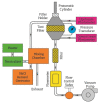Dry Heat as a Potential Decontamination Method on the Filtration Efficiency of Filtering Facepiece Respirators
- PMID: 35742417
- PMCID: PMC9223160
- DOI: 10.3390/ijerph19127167
Dry Heat as a Potential Decontamination Method on the Filtration Efficiency of Filtering Facepiece Respirators
Abstract
Filtering facepiece respirators have been widely used in the fields of occupational health and public hygiene, especially during the COVID-19 pandemic. In particular, disposable respirators have been in high demand, and the waste generated from these disposable products poses a problem for the environment. Here, we aimed to test a practical decontamination method to allow for the reuse of KN95 respirators. In this study, three types of KN95 respirators were heated at 80 °C and 90 °C for different durations (15 min, 30 min, 45 min, 1 h, 2 h, 3 h, 4 h, 6 h, 8 h, 10 h, and 24 h). The filtration efficiencies of the tested KN95 respirators before and after heating were measured, and the changes in microstructure were imaged with a scanning electron microscope (SEM). In addition, a neural network model based on the nonlinear autoregressive with external input (NARX) to predict the filtration efficiency of the KN95 respirator was established. The results show that the temperature and time of dry heating affected particle prevention. The higher the temperature and the longer the heating time, the more obvious the decline in the filtration efficiency of the respirators. When the heating temperature reached 100 °C, the respirator may be no longer suitable for reuse. These results show that a dry heat temperature between 70 °C and 90 °C, and a heating time between 30 min and 2 h is assumed to be a suitable and effective decontamination method for respirators.
Keywords: filtering facepiece respirators; filtration efficiency; heat treatment; neural network.
Conflict of interest statement
The authors declare no conflict of interest.
Figures















Similar articles
-
Reusability of filtering facepiece respirators after decontamination through drying and germicidal UV irradiation.BMJ Glob Health. 2020 Oct;5(10):e003110. doi: 10.1136/bmjgh-2020-003110. BMJ Glob Health. 2020. PMID: 33087392 Free PMC article.
-
Filtration efficiency of N95 filtering facepiece respirators during multi-cycles of '8-hour simulated donning + disinfection'.J Hosp Infect. 2022 Sep;127:91-100. doi: 10.1016/j.jhin.2022.06.016. Epub 2022 Jul 2. J Hosp Infect. 2022. PMID: 35792275 Free PMC article.
-
Aerosolized Hydrogen Peroxide Decontamination of N95 Respirators, with Fit-Testing and Viral Inactivation, Demonstrates Feasibility for Reuse during the COVID-19 Pandemic.mSphere. 2022 Oct 26;7(5):e0030322. doi: 10.1128/msphere.00303-22. Epub 2022 Aug 30. mSphere. 2022. PMID: 36040048 Free PMC article.
-
Decontamination Methods for Reuse of Filtering Facepiece Respirators.JAMA Otolaryngol Head Neck Surg. 2020 Aug 1;146(8):734-740. doi: 10.1001/jamaoto.2020.1423. JAMA Otolaryngol Head Neck Surg. 2020. PMID: 32614377 Free PMC article. Review.
-
Decontamination Strategies for Filtering Facepiece Respirators (FFRs) in Healthcare Organizations: A Comprehensive Review.Ann Work Expo Health. 2021 Jan 14;65(1):26-52. doi: 10.1093/annweh/wxaa090. Ann Work Expo Health. 2021. PMID: 32929450 Review.
References
-
- Department of Planning Development. Informatization Health Commission Statistical Bulletin of China Health Development. [(accessed on 20 May 2022)]; Available online: http://www.nhc.gov.cn/guihuaxxs/s10743/202107/af8a9c98453c4d9593e07895ae....
-
- Xiaobin Y., Jun C., Xin Z. Particle size conversion for mask filter efficiency test and comparability of different standards. J. Text. Res. 2020;41
-
- Hongjie P., Xiaobin Y., Chuan Z., Shouxing Z., Suqin C., Hongseng L. Comparison of filtration efficiency standards for COVID-19 protective masks. J. Text. Res. 2021;42:97–105.
-
- Jin T., Yiming S. Effect of working dust on the protective performance of self-priming filter anti-particulate respirator; Proceedings of the Collection of the 25th Cross-Strait and Hong Kong, Macau Occupational Safety and Health Academic Research Association and China Occupational Safety and Health Association Academic Annual Conference and Science and Technology Award Conference 2017; Urumqi, China. 20 September–22 September 2017.
-
- Asbach C., Held A., Kiendler-Scharr A., Scheuch G., Schmid H.-J. Position Paper of the Gesellschaft für Aerosolforschung on Understanding the Role of Aerosol Particles in SARS-CoV-2 Infection. Gesellschaft für Aerosolforschung e. V.; Cologne, Germany: 2021.
Publication types
MeSH terms
Grants and funding
LinkOut - more resources
Full Text Sources
Medical

